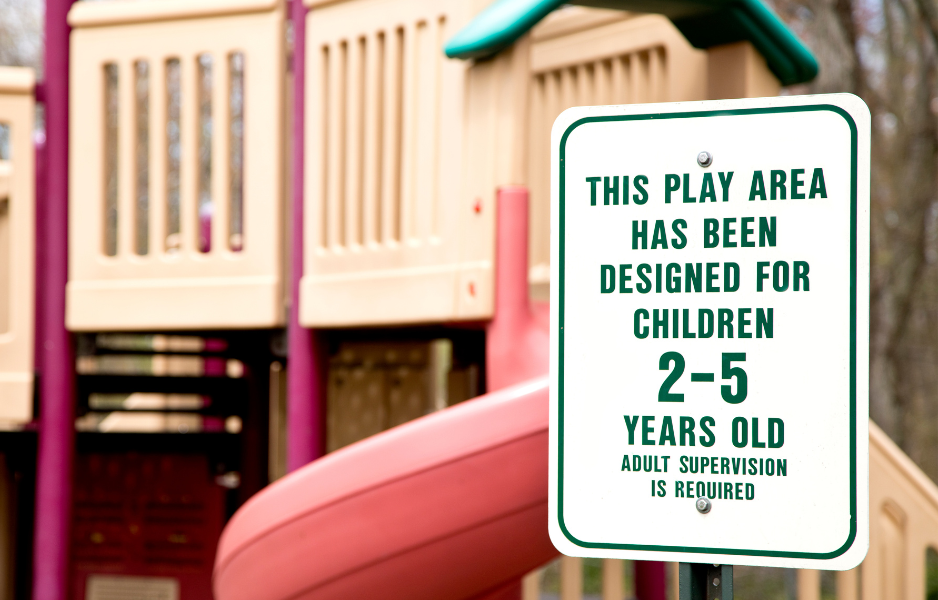Public Playgrounds: 5 Common Safety Issues

James Weagley, Sports Safety Consultant
Well over 200,000 public playground injuries are treated in hospital emergency rooms across the country each year. Fractures account for 40% of all injuries, while concussions and lacerations are among other commonly occurring injuries. Falls from playground equipment are often the primary cause of these injuries.
The Consumer Product Safety Commission (CPSC) and American Society for Testing and Materials (ASTM) cooperatively developed voluntary playground safety standards beginning in 1981. The CPSC’s Public Playground Safety Handbook provides recommendations for public playground areas and equipment to be used alongside ASTM standards for evaluating playground equipment safety. Many states, including Arkansas, California, Connecticut, Florida, Illinois, Michigan, New Jersey, and North Carolina, require compliance with all or part of these guidelines and standards.
Parents, educators, and playground maintenance crews should be aware of the common safety issues with public playgrounds summarized below:
1. Signage
CPSC’s Public Playground Safety Handbook identifies and separates playground areas according to age, based on physical readiness. It recommends that playground areas should be designated for toddlers (ages 6 through 23 months), preschool-age children (ages 2 through 5 years), and school-age children (ages 5 through 12 years). Signs are useful tools to provide supervisors with guidance on the intended age group of the equipment in a designated area. However, some public playgrounds lack any signs of this nature.
2. Regular Inspection and Maintenance
Oftentimes an injury results because equipment has not been properly maintained. According to the Public Playground Safety Handbook, playgrounds should adhere to a regular inspection and maintenance schedule. This should include the inspection of all playground areas and equipment, checking for deterioration and potential hazards. Maintenance department staffing issues have been noted as contributing factors related to previous playground injury cases, however, this hardly qualifies as a credible defense for failing to comply with safety standards and requirements.
3. Equipment Repairs
Problems found during an inspection should be fixed as soon as possible. Any repairs performed on playground equipment should be made using manufacturer-made products approved by the CPSC and ASTM. Attempting to provide a cheaper, “homemade” solution can result in a situation where the equipment does not function as designed and may cause an accident. “DIY” remedies will also void any manufacturer warranties that would otherwise apply to that equipment.
For example, one case involved a swing that had a broken chain. A municipal maintenance department welded a piece of metal to repair the chain, which resulted in a different length than the opposite side chain. Consequently, the swing was not balanced properly and a young child suffered serious injury after falling from it.
4. Surfacing Material
Since falls are a frequent cause of playground injuries, it is important that surface materials provide impact attenuation to protect against severe injuries. Impact attenuation is the measure of the shock absorbing properties of the surfacing material. Various materials can be used, ranging from sand or wood bark mulch to commercially installed rubber. Note that these materials possess different shock absorption properties. For example, 6 inches of approved rubberized surface material will adequately protect a child falling from 10 feet from a head injury. Ensuring the same level of protection with wood bark mulch would require 9 inches.
Wood bark mulch is often used on playground surfaces as a more cost-effective alternative to other available options. However, this material requires regular maintenance at more frequent intervals, to rake and replenish the wood bark mulch because it moves and compresses easily.
A playground should never be installed on surfaces that lack sufficient shock absorption, such as concrete or asphalt, to prevent injury.
5. Railings and Barriers
Railings and barriers are necessary to prevent falls and subsequent injuries from elevated platforms, walkways, landings, stairways, and transitional surfaces. CPSC’s Public Playground Safety Handbook provides specific age-related guidance to determine if a railing or barrier is needed and how high it should be.
For example, an incident occurred at an indoor playground structure at a mall that was specifically designed for toddlers. A child lost their balance and fell from the slide platform, which did not have any railings or barriers. These safety features are especially important for areas like slide platforms, where younger children are likely to lose their balance when transitioning from a standing to seated position.
Recommended Resources
U.S. Consumer Product Safety Commission. (2010). Public Playground Safety Handbook. https://www.cpsc.gov/s3fs-public/325.pdf
National Electronic Injury Surveillance System (NEISS): https://www.cpsc.gov/Research–Statistics/NEISS-Injury-Data
Categories: Education | Safety | Sports & RecreationTags: ASTM Standards | Attenuating Surfaces | CPSC | Playground Equipment | Supervision


